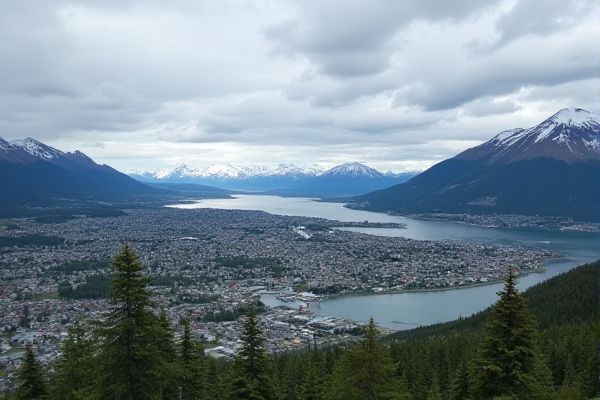
Internet and telecommunications options in Alaska: Limited service providers available. Mobile coverage varies by region. Satellite internet as alternative. Rural areas with slower speeds. Fiber-optic availability increasing. High-speed plans can be costly. Internet bundle options available. Weather can affect connectivity. Government broadband initiatives ongoing. Local ISPs may offer deals.
Limited service providers available.
In Anchorage, Alaska, the internet and telecommunications options are limited, with primary providers including Alaska Communications and GCI, offering fiber, cable, and DSL services. Meanwhile, satellite providers like Hughesnet and Viasat serve rural areas due to the state's challenging geography and sparse population.
Mobile coverage varies by region.
Mobile coverage in Alaska varies significantly by region, with AT&T offering the best 4G network coverage, covering about 11.4% of the state's area and 47.6% of its zip codes. Other providers like Verizon, Bristol Bay Cellular, and OTZ Telecom have more limited but still notable coverage, particularly in urban and some rural areas. For detailed information, [Mobile and Cell Coverage in Alaska](https://bestneighborhood.org/mobile-and-cell-alaska/) offers comprehensive insights into the availability and quality of service across the state.
Satellite internet as alternative.
Satellite Internet in Alaska, such as plans from HughesNet and Starlink, serves as a vital alternative, especially in remote areas where other options like DSL, cable, and fiber are not available. These services, though often more expensive and with lower speeds, provide the only viable internet access for many rural residents, with plans starting at around $50-$90 per month. For more information, you can explore the Best Internet Providers in Alaska to understand further options available in these lesser-connected areas.
Rural areas with slower speeds.
Rural Alaska faces significant challenges with internet access, as approximately 60,000 people have no broadband and 200,000 have only low-end broadband, meaning speeds below 10/1 Mbps. The current solutions often rely on outdated satellite technology, which is both slow and expensive. However, there are promising advancements on the horizon; innovations in satellite technology, such as Geostationary High Throughput satellites and Low Earth Orbit satellites, present the potential for significant improvements. Moreover, the Alaska Tribal Network (ATN) is actively working to provide affordable broadband by utilizing Tribal 2.5 GHz spectrum and securing government funding to expand both fiber and wireless connections.
Fiber-optic availability increasing.
Fiber-optic availability in Alaska is increasing, albeit slowly, with projects like Cordova Telecom Cooperative's submarine fiber optic cable and GCI's Aleutians Fiber Project expanding fiber access to remote areas, despite the challenges posed by the state's terrain and weather.
High-speed plans can be costly.
High-speed internet plans in Alaska can be costly, with top-tier plans from providers like GCI and Alaska Communications offering speeds up to 2,500Mbps but starting at prices around $80 to $190 per month. This reflects the state's limited and expensive internet options. For a more detailed overview of these providers in Alaska, visit the Best Internet Providers page on CNET, which offers comprehensive insights into the available plans and pricing.
Internet bundle options available.
GCI provides internet bundle options that include discounts and involve combinations with other services such as video, mobile, and free premium WiFi powered by Plume(r). Their No Worries plans begin at $89.99 per month with speeds reaching 250 Mbps, along with unlimited 5G mobile for $30 per line when you have GCI internet. In contrast, Alaska Communications offers various internet plans, including fiber and DSL options, but they do not feature the same level of bundling discounts as GCI.
Weather can affect connectivity.
Weather can significantly affect internet connectivity in Alaska, particularly in rural areas where satellite, fixed wireless, and DSL connections are more common and vulnerable to disruptions due to harsh weather conditions, such as heavy precipitation, strong winds, and storm surges. According to CNET, the choice of a reliable internet provider is crucial for ensuring stable service amidst these challenges. Selecting a service with robust infrastructure and support can mitigate these potential disruptions, providing residents with more reliable connectivity even in less favorable weather conditions.
Government broadband initiatives ongoing.
The Biden-Harris Administration has approved Alaska's Initial Proposal for the Broadband Equity, Access, and Deployment (BEAD) program, allowing the state to access over $1 billion in funding to expand broadband services to unserved and underserved areas. This initiative is part of the "Internet for All" program aimed at closing the digital divide and providing affordable, reliable high-speed internet across the state.
Local ISPs may offer deals.
Local ISPs in Alaska, such as Alaska Communications and GCI, offer a range of deals and plans to cater to your internet needs. These options include both fiber and cable services, boasting speeds up to 2,500Mbps. Prices start at around $60-$80 per month for Alaska Communications and $89.99-$190 per month for GCI. Many of these plans feature enticing benefits like unlimited data and no equipment fees. For more information on the best offerings, visit Best Internet Providers in Alaska on CNET to explore what suits you best.
